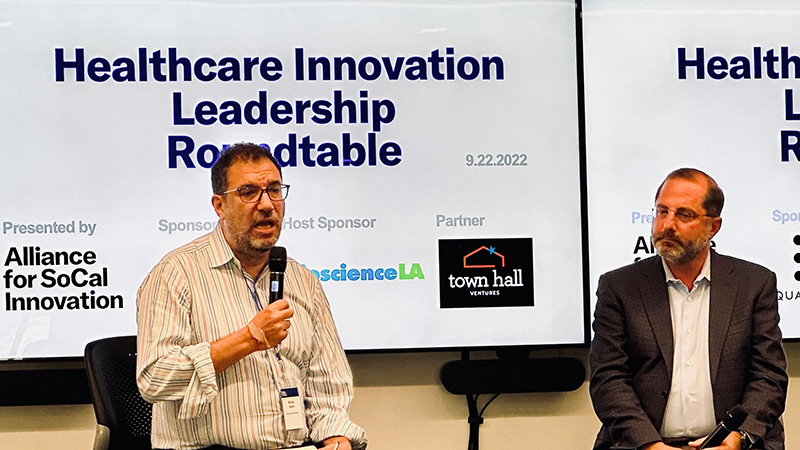
Insight by: Dave Whelan
A few weeks ago, BioscienceLA and The Alliance for SoCal Innovation teamed up to bring together two healthcare veterans: Andy Slavitt, General Partner of Town Hall Ventures* and former CMS and COVID response leader, and Alex Azar, the 24th Secretary of the US Department of Health and Human Services.
The star power on stage was equaled by the star power in the audience. The BioscienceLA Collaboration Hub was filled with leaders from academia, hospitals and health systems, venture capital and investment firms, big pharma, and technology start-ups. We had perspectives from across the political spectrum, across the technology spectrum, and across the industry spectrum – indeed, across the entire healthcare value chain.
These different perspectives led to some very engaging and energetic conversations between the speakers and the audience. We touched on the state of healthcare – what’s working and what’s not. We shared stories of innovation and obstacles. And we brainstormed ways to support each other to move this innovation forward. By the time the roundtable had moved to dinner in our courtyard, some of us were kicking off new strategic partnerships.
As we converged on solutions (or, at the very least, commitments to develop solutions together), I was struck not just by the convergence in the room, but by the bigger meanings of convergence that underpinned so much of the conversation.
I’ve shared some thoughts on this before. Last month, I showed how rural healthcare and urban healthcare have much to learn from each other (“Doc Hollywood 2.0”). I’ve discussed how we must avoid data siloes by integrated and acting on more comprehensive sets of data (“Show Me the Data!”). I’ve even shared my thoughts on why Los Angeles is an emerging hub for innovation that spans technologies and disciplines (“LA is Big. And Connected. And Could Be the Future of RPM.”).
One theme that is running through my musings is that of convergence. As I often share in my presentations to visiting delegations and elected officials, if the 19th century was the industrial revolution, and the 20th century was the information revolution, the 21st century is the biological revolution. What I love is that one of the 20th century’s most impactful technology visionaries and leaders, Apple founder Steve Jobs, was all in on the century of biology before his death in 2011, saying, “The biggest innovations of the 21st century will be at the intersection of biology and technology. A new era is beginning.” If that’s not an inspiration to think different when it comes to healthcare, I don’t know what is.
The intersection of technology and healthcare is but one take on the concept of convergence. There are many others:
- The convergence of payor and provider perspectives is often referenced in the context of value-based healthcare, where closer alignment results in better quality, cost, and value for patients and other stakeholders. Vertically integrated healthcare providers represent an extreme version of this convergence. (“Convergence in Healthcare: What is it? And Why Now?” Chilmark Research, 29 September 2017)
- As shopping centers and other brick-and-mortar retailers continue to reinvent themselves in a post-Amazon and post-pandemic world, healthcare and retail continue to converge. From concierge medicine to urgent care, diagnostic testing to human performance, healthcare concepts are taking over empty storefronts in malls, putting them under the same roof as Apple, Peloton, and Best Buy, all of which offer their own health solutions. (“How Industry Convergence is Reshaping the Future of Healthcare and Retail,” Huron Consulting Group)
- The entry into healthcare by adjacent (and sometimes not so adjacent) industries has been growing for a while, and pandemic may have accelerated this trend. “Many non-traditional players are entering the healthcare space offering their expertise, reconfiguring their products for healthcare contexts, or creating new partnerships with health systems…. For an industry that has often operated with a lot of pride and self-sufficiency, it is refreshing to see that health leaders are open to asking for help.” (“Coming together: Multi-sector convergence in healthcare,” KPMG, 2021)
- The convergence of patient and provider (and the shift of power to the patient) is another trend that has continued to accelerate during pandemic. Among others, Eric Topol wrote about this several years ago in The Patient Will See You Now: The Future of Medicine is in Your Hands. Many of the examples that he cites are wonderful examples of how technology can put power in the hands of the patient, much like personal computers put power in the hands of Apple customers in the 1980s.
- Finally, I often speak about the rich network of innovation that defines life sciences in the Los Angeles region. We are not a biotech hub like Boston or a technology center like Silicon Valley, but LA brings together a unique mix of biotech, medtech, and digital health. That convergence is supported by numerous other industries that help to define our unique innovation mindset.
As healthcare continues to be the largest segment of the economy, it is no wonder that it is so connected to other industries and sectors. As healthcare continues to grow, its challenges grow with it, but so too do the potential solutions. As our roundtable conversation reinforced, those solutions are unlikely to come from one perspective or be implemented by one organization. The opportunity is in the convergence.
*One of Andy’s partners at Town Hall Ventures is David Whelan. I am not him. He is not me. But, as two leaders in the healthcare innovation world, we have been mistaken for each other many times. Perhaps we will bump into each other at HLTH in Las Vegas.





